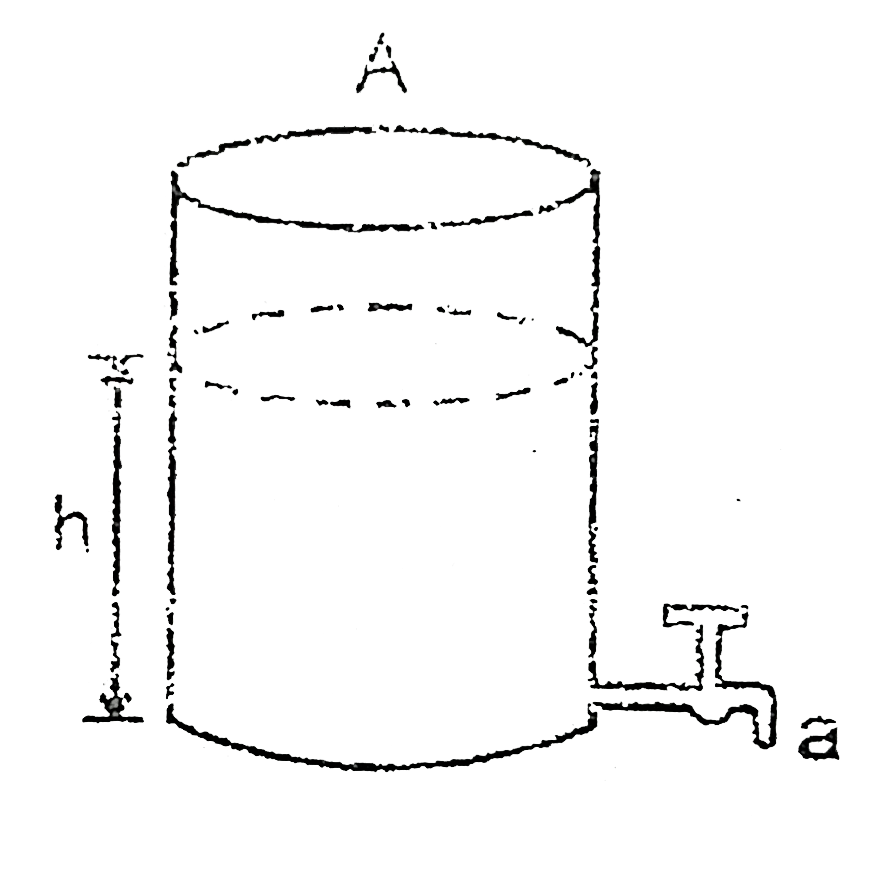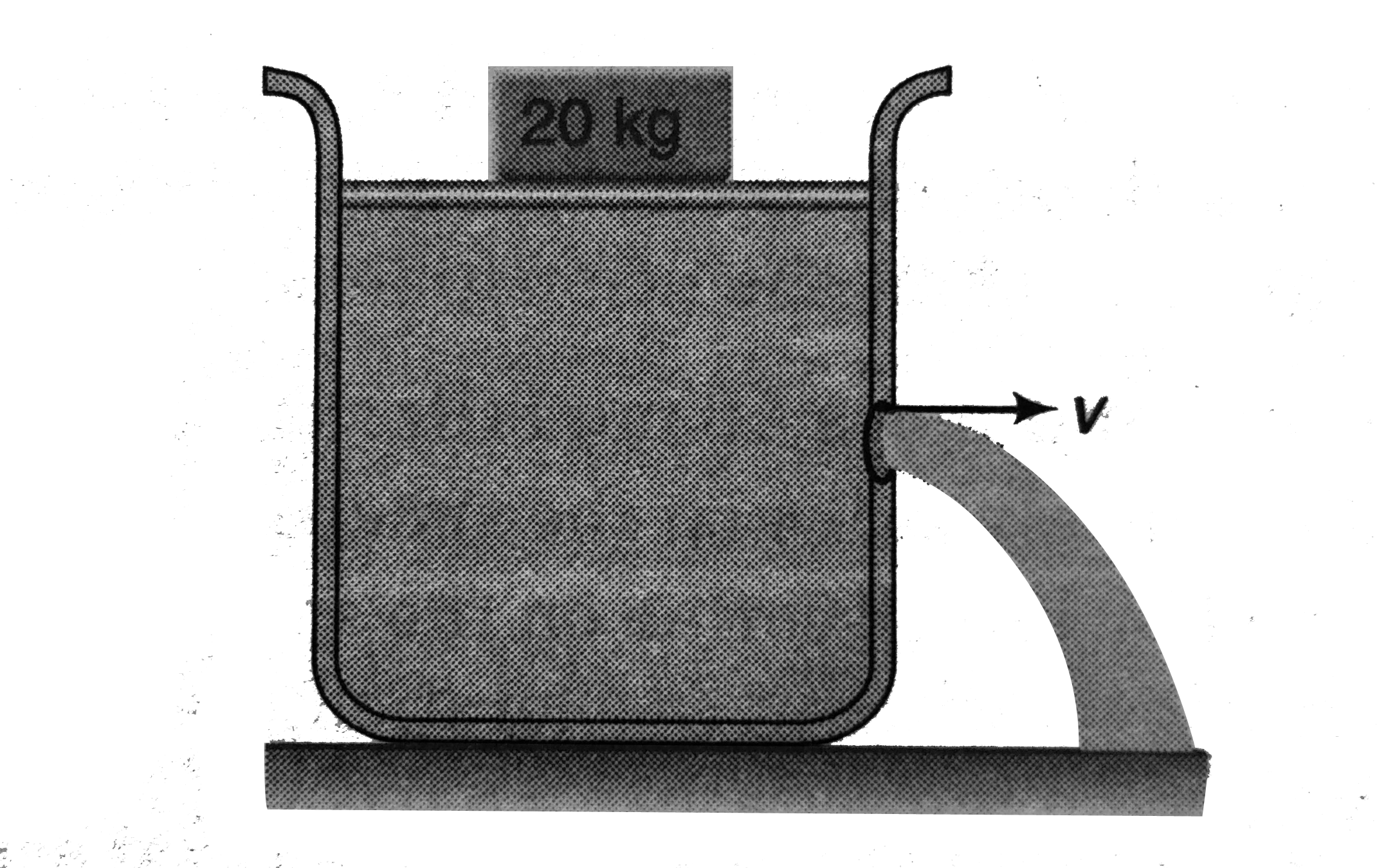A cylindrical tank of cross sectional area a1 is filled with water to a height h. A hole of cross sectional area a2 is made at the bottom. If a1=5a2, then find the
(i) initial velocity with which the water falls in tank.
(ii) initial velocity with which water emerges out from hole.
(iii) time taken to make the tank empty.
To solve the problem step by step, we will break down each part of the question systematically.
Given:
- Cross-sectional area of the tank, A1=5A2
- Height of water in the tank, h
- Cross-sectional area of the hole, A2
(i) Initial velocity with which the water falls in the tank (V1)
1. Using Bernoulli's Equation:
We apply Bernoulli's principle between two points: point A (just below the water surface) and point B (just below the hole).
PA+ρgh+12ρV21=PB+12ρV22
Here, PA=PB (both are atmospheric pressure), so they cancel out.
2. Rearranging the equation:
ρgh+12ρV21=12ρV22
Dividing through by ρ:
gh+12V21=12V22
3. Using the continuity equation:
The continuity equation states that:
A1V1=A2V2
Substituting A1=5A2:
5A2V1=A2V2⟹V2=5V1
4. Substituting V2 back into the Bernoulli equation:
gh+12V21=12(5V1)2
gh+12V21=252V21
Rearranging gives:
gh=252V21−12V21=12V21
V21=gh12
V1=√gh12
(ii) Initial velocity with which water emerges out from the hole (V2)
1. Using the relationship from the continuity equation:
V2=5V1
Substituting V1:
V2=5√gh12=√25gh12
(iii) Time taken to make the tank empty
1. Using the relation between velocity and height:
The velocity of water falling in the tank is given by:
V1=−dhdt
Rearranging gives:
dt=−dhV1
2. Substituting V1:
dt=−dh√gh12=−√12gdh√h
3. Integrating:
t=−√12g∫0hh−1/2dh
The integral evaluates to:
t=−√12g(2√h)0h=2√12g√h
t=2√12hg=2√12h√g
Summary of Results:
- (i) V1=√gh12
- (ii) V2=√25gh12
- (iii) t=2√12h√g
- Cross-sectional area of the tank, A1=5A2
- Height of water in the tank, h
- Cross-sectional area of the hole, A2
We apply Bernoulli's principle between two points: point A (just below the water surface) and point B (just below the hole).
PA+ρgh+12ρV21=PB+12ρV22
ρgh+12ρV21=12ρV22
gh+12V21=12V22
The continuity equation states that:
A1V1=A2V2
Substituting A1=5A2:
5A2V1=A2V2⟹V2=5V1
gh+12V21=12(5V1)2
gh+12V21=252V21
Rearranging gives:
gh=252V21−12V21=12V21
V21=gh12
V1=√gh12
V2=5V1
Substituting V1:
V2=5√gh12=√25gh12
The velocity of water falling in the tank is given by:
V1=−dhdt
Rearranging gives:
dt=−dhV1
dt=−dh√gh12=−√12gdh√h
t=−√12g∫0hh−1/2dh
The integral evaluates to:
t=−√12g(2√h)0h=2√12g√h
t=2√12hg=2√12h√g
- (i) V1=√gh12
- (ii) V2=√25gh12
- (iii) t=2√12h√g
Topper's Solved these Questions
- MECHANICAL PROPERTIES OF FLUIDSBOOK - MODERN PUBLICATIONCHAPTER - MECHANICAL PROPERTIES OF FLUIDSEXERCISE - NCERT (Textbook Exercises)
20 Videos
- MECHANICAL PROPERTIES OF FLUIDSBOOK - MODERN PUBLICATIONCHAPTER - MECHANICAL PROPERTIES OF FLUIDSEXERCISE - NCERT (Additional Exercises)
11 Videos
- MECHANICAL PROPERTIES OF FLUIDSBOOK - MODERN PUBLICATIONCHAPTER - MECHANICAL PROPERTIES OF FLUIDSEXERCISE - Conceptual Questions
29 Videos
- MATHEMATICAL TOOLSBOOK - MODERN PUBLICATIONCHAPTER - MATHEMATICAL TOOLSEXERCISE - PRACTICE PROBLEMS (10)
12 Videos
- MOTION IN A PLANE BOOK - MODERN PUBLICATIONCHAPTER - MOTION IN A PLANE EXERCISE - Chapter Practice Test
15 Videos
Similar Questions
A cylindrical vessel of area of cross section A is filled with a liquid up to a height H. A very small hole of area of cross section a is made at the bottom of the vellel. Find the time taken by the vessel to become empty.
View Solution_S01_030_Q01.png)
A cylinderical tank 1 m in radius rests on a plaform 5 m high. Initially the tank is filled with upto a height of 5m a plug whose area is 10−4cm2 is removed from an orifice on the side of the tank at the bottom.
Calculate (a). Initial speed with which the water flows from the orifice
(b). Initial speed with which the water strikes the ground.
View Solution
Knowledge Check
A cylindrical tank having cross-sectional area A is filled with water to a height of 2.0 m. A circular hole of corss-section area is opened at a height of 75 cm from the bottom. If a/A=√0.2, then velocity with which waer emerges from the hole is
(g=9.8ms−2)A4.9ms−1B4.95ms−1C5.0ms−1D5.5ms−1A large cylindrical tank has a hole of area A at its bottom. Water is oured in the tank by a tube of equal cross sectional area A ejecting water at the speed v.
Athe water level in the tank wil keep on rising.Bno water an be stored in the tankCthe water level will rise to a height v22g and then stopDthe water level will oscillate.A tank of height 5 m/s completely filled with water. There is a hole of cross sectional area 1cm2 near its bottom. What is the initial volume of water that will come out of the hole per second. (Use g=10m/s2)
A10−3m3/sB2×10−3m3/sC3×10−2m3/sD4×10−3m3/s
A cylindrical container of cross-section area, A is filled up with water upto height 'h' Water may exit through a tap of cross sectional area 'a' in the bottom of container. Find out

(a) Velocity of water just after opening of tap.
(b) The area of cross-section of water stream coming out of tape at depth h0 below tap in terms of 'a' just after opening of tap.
(c) Time in which conainer becomes empty.
(Given : (aA)1/2=0.22,h=20cm,h0=20cm
View SolutionThe water level on a tank is 5m high. There is a hole of 1cm2 cross-section at the bottom of the tank. Find the initial rate with which water will leak through the hole. (g=10ms−2)
View SolutionA long cylindrical tank of cross-sectional area 0.5m2 is filled with water. It has a small hole at a height 50cm from the bottom. A movable piston of cross-sectional area almost equal to 0.5m2 is fitted on the top of the tank such that it can slide in the tank freely. A load of 20kg is applied on the top of the water by piston, as shown in the figure. Calculate the speed of the water jet with which it hits the surface when piston is 1m above the bottom. (Ignore the mass of the piston)

View SolutionA tank of square cross section (2m×2m) is filled with water up to a height of 2.5m. Find the thrust experienced by the vertical and botom of the tank (g=10m/s2).
View SolutionA cylindrical tank with a large diameter is filled with water to a depth D =0.30 m. A hole of cross-sectional area A = 6.2 cm2 in the bottom of the tank allows water to drain out. (a) What is the drainage rate in cubic meters per second? (b) At what distance below the bottom of the tank is the cross-sectional area of the stream equal to one half the area of the hole?
View Solution
